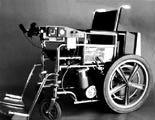A Case Study: The Ultrasonic Head Controlled Wheelchair and Interface David L. Jaffe, MS The design, development, and technology transfer activities associated with the Ultrasonic Head Controlled Wheelchair (UHCW) has extended over the past ten years. It has involved my efforts as principal investigator as well as other researchers, students, test pilots, potential manufacturers, funding agencies, and personnel from the VA Rehabilitation R&D Evaluation Unit (REU) in Baltimore. This account briefly documents the history of bringing this design to commercial reality.
After the students graduated and went their separate ways, the project was moved to the RR&D Center where I continued to refine and publicize the design. In November of 1980, the project was awarded 4th prize in the Johns Hopkins Personal Computer Applications Competition in Washington, DC. At the System Sciences Conference in Honolulu, it was judged the best paper. And in March of 1981, the wheelchair was demonstrated at the ASME annual conference in Chicago. Despite many demonstrations of this new mobility control concept, the students' solution was far from a practical vehicle. Its deficiencies were many. The method of loading the computer program from disk storage was both time consuming and could not be performed by a disabled user. The disk drives and CRT required a source of AC power during the loading phase, which might not be available in places where the chair might travel. The software proved difficult to maintain and modify. Although these problems could not be easily corrected on the existing prototype chair, the project did show the feasibility of computer controlled mobility directed by head position. It also showed that the ultrasonic sensor system could detect obstacles and take appropriate action. The practical execution of these concepts would have to be accomplished in a later design. Second generation design With that funding, advances in computer hardware, and new developments in high level programming languages, a new Ultrasonic Head Controlled Wheelchair was developed by the first half 1983. The computer's instructions were then permanently stored on a memory chip and the entire computer was powered by the wheelchair's batteries. A more accurate and faster technique of acquiring head position information improved the steering and control characteristics. In May, 1983 the first disabled user test drove the new design and in June it was demonstrated at the RESNA conference in San Diego. A dozen quadriplegic patients at the Palo Alto VA Spinal Cord Injury Service subsequently tested the prototype. In response to many technical inquires about the wheelchair, I compiled a sixty-five page Technical Manual. It contains complete descriptions of the workings of the UHCW, including schematics, wiring diagrams, computer program source code, and parts list. With this document a knowledgeable engineer in an adequately equipped laboratory could duplicate the head controlled wheelchair. In the past five years over one hundred investigators, researchers, and interested manufacturers world-wide have received copies of the manual. In 1985, as work was progressing on a voice controlled mobile robot, modifications to the wheelchair-mounted head control unit were made to enable its use in specifying movement trajectories. This capability would allow the severely disabled user to control complex robot movements using only head motions. Despite continuing interest in the wheelchair and ultrasonic distance ranging technology, no manufacturer had stepped forward to pursue commercial development of the design. In mid-1985, the Rehabilitation R&D Evaluation Unit (REU) was formed within the VA system. (For a description of REU, see the related article in this newsletter.) A Request for Evaluation for the UHCW from RR&D was one of the first to be received and approved by this new agency. The evaluation contract Under the REU program, clinical evaluation is to be accomplished at several VA facilities. A protocol has been developed by REU encompassing testing methods, questionnaires, subject selection, and data collection methods. The process is estimated to take about one year and if successful, will result in an approval for VA physicians to prescribe the UHCW for quadriplegic veterans. By virtue of their early involvement in this project, Eureka will be in a good position to fill any orders for UHCW's submitted by the VA or other third-party payers. While the events described above may not be typical or even necessary for other projects, they do show what it takes bring a good project idea to the point of commercialization: a concerted, long-term technical effort, several infusions of funding, and plenty of patience on the part of RR&D Center investigators. This case also illustrates the advantage to all parties when manufacturers become aware of projects in their early stages. The R&D team, the manufacturers and the end user all benefit from this early involvement. |
